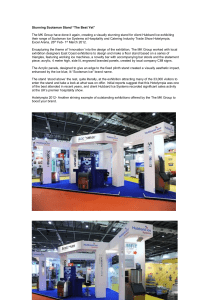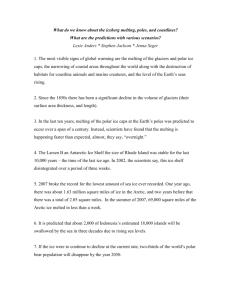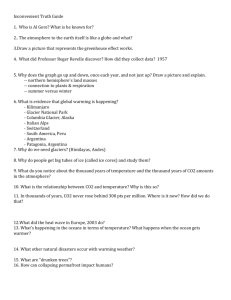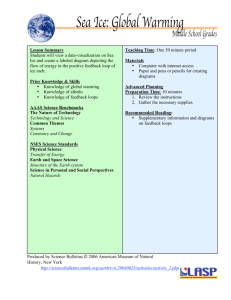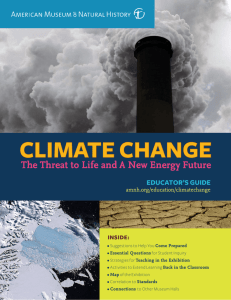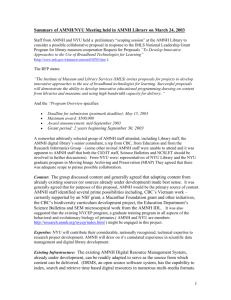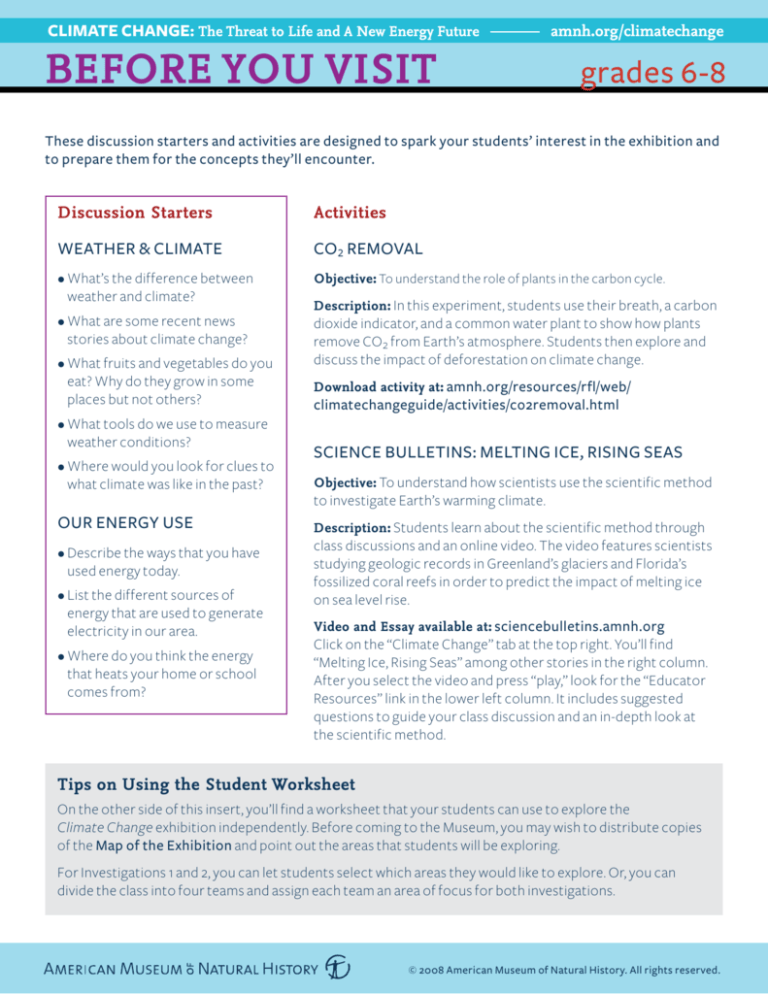
CLIMATE CHANGE: The Threat to Life and A New Energy Future
BEFORE YOU VISIT
amnh.org/climatechange
grades 6-8
These discussion starters and activities are designed to spark your students’ interest in the exhibition and
to prepare them for the concepts they’ll encounter.
Discussion Starters
Activities
WEATHER & CLIMATE
CO 2 REMOVAL
• What’s the difference between
weather and climate?
Objective: To understand the role of plants in the carbon cycle.
• What are some recent news
stories about climate change?
dioxide indicator, and a common water plant to show how plants
remove CO2 from Earth’s atmosphere. Students then explore and
discuss the impact of deforestation on climate change.
• What fruits and vegetables do you
eat? Why do they grow in some
places but not others?
• What tools do we use to measure
weather conditions?
• Where would you look for clues to
what climate was like in the past?
OUR ENERGY USE
• Describe the ways that you have
used energy today.
• List the different sources of
energy that are used to generate
electricity in our area.
• Where do you think the energy
that heats your home or school
comes from?
Description: In this experiment, students use their breath, a carbon
Download activity at: amnh.org/resources/rfl/web/
climatechangeguide/activities/co2removal.html
SCIENCE BULLETINS: MELTING ICE, RISING SEAS
Objective: To understand how scientists use the scientific method
to investigate Earth’s warming climate.
Description: Students learn about the scientific method through
class discussions and an online video. The video features scientists
studying geologic records in Greenland’s glaciers and Florida’s
fossilized coral reefs in order to predict the impact of melting ice
on sea level rise.
Video and Essay available at: sciencebulletins.amnh.org
Click on the “Climate Change” tab at the top right. You’ll find
“Melting Ice, Rising Seas” among other stories in the right column.
After you select the video and press “play,” look for the “Educator
Resources” link in the lower left column. It includes suggested
questions to guide your class discussion and an in-depth look at
the scientific method.
Tips on Using the Student Worksheet
On the other side of this insert, you’ll find a worksheet that your students can use to explore the
Climate Change exhibition independently. Before coming to the Museum, you may wish to distribute copies
of the Map of the Exhibition and point out the areas that students will be exploring.
For Investigations 1 and 2, you can let students select which areas they would like to explore. Or, you can
divide the class into four teams and assign each team an area of focus for both investigations.
© 2008 American Museum of Natural History. All rights reserved.
CLIMATE CHANGE: The Threat to Life and A New Energy Future
amnh.org/climatechange
STUDENT WORKSHEET
grades 6-8
1. Investigate the Evidence for Climate Change
Select an exhibition area for your first investigation:
Changing Atmosphere
Changing Ice
Changing Ocean
Changing Land
Locate a piece of evidence that shows Earth’s climate is changing. Evidence can include samples (e.g., tree rings
ice cores, brain coral), charts, and maps. Use the back of this page to record your responses to these questions:
• What is the evidence?
• Sketch and label it.
• How did scientists collect the evidence? What tools were used?
• What question about climate change does this evidence help us answer?
2. Investigate the Consequences of Climate Change
Select an exhibition area for your second investigation:
Changing Atmosphere
Changing Ice
Changing Ocean
Changing Land
Describe a way in which climate change affects human society.
Choose a plant or animal (including humans). Describe how it has been or might be affected by warming
temperatures.
3. What Can We Do?
Explore the Making a Difference area. What actions can your school or community take to reduce carbon
dioxide (CO2) emissions?
© 2008 American Museum of Natural History. All rights reserved.
Climate Change Educator’s Guide
Answers to Student Worksheets
Grades 6-8
1. Investigate the Evidence for Climate Change
Answers may vary. Types of evidence include ice core, tree rings, brain coral fossil, and sediment core.
2. Investigate the Consequences of Climate Change
Describe a way in which climate change affects human society.
Answers will vary. They may include: Droughts could disrupt agriculture, causing starvation. Storm surges and
rising sea levels could displace the hundreds of millions of people who live on or near seacoasts. Changes in temperatures and the distribution of rainfall could lead to disease outbreaks.
Choose a plant or animal (including humans). Describe how it has been or might be affected
by warming temperatures.
Answers will vary. They may include: Melting Arctic sea ice and permafrost (frozen land) is disturbing the places
where many polar animals hunt, nest, and breed. Changes in ocean water threaten populations of phytoplankton. These microscopic plants form the base of the ocean’s complex food chains, so this could affect animals
throughout the ocean.
3. What Can We Do?
What actions can your school or community take to reduce carbon dioxide emissions?
Answers will vary. They may include: Conduct school- or community-wide campaigns — using leaflets, posters, or announcements in school assemblies — that promote actions that individuals can take to slow climate
change. Work with local organizations to promote public transportation, tree-planting, energy-efficient
construction, and large-scale recycling programs. Get involved in Earth Day and other renewable-energy or
conservation-oriented activities.
© 2008 American Museum of Natural History. All rights reserved.


